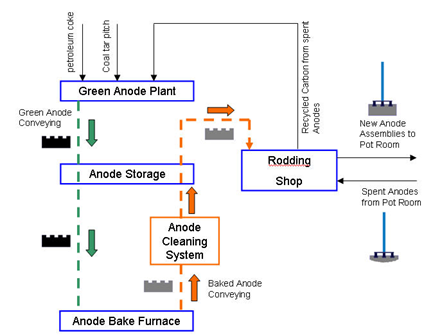

Manufacturers are under continuous pressure to lower costs and improve quality. To assure optimum technical and financial performance of the Carbon Plants and anode block manufacturing, Aluminium manufacturers are moving forward in the adoption and integration of Industry 4.0 technologies as part of their roadmap to the aluminium plant of the future.
One of the main ideas that separate Industry 4.0 from 3.0 is the notion that data coming from one part of the manufacturing process can help with upstream or downstream process optimization. In a typical modern anode manufacturing plant, all of the equipment and systems are tied together with an industrial network, a good foundation for the integration of technologies. Looking at an aluminium smelter on how Industry 4.0 technologies can be beneficial.
{alcircleadd}Anode quality is a key variable of overall efficiency and production costs. Any improvements in quality will help lower energy consumption, lower greenhouse gas (GHG) emissions and increase productivity. Furthermore, inputs to the anode production process such as petroleum coke and coal tar pitch are variable and difficult to control. The process which supports the continuous supply of the pre-baked carbon anodes requires independent production and operation facilities:
For a fully integrated, automated smelter, the physical system that ties all of the above independent process plants together is the Anode Handling and Cleaning System.

Figure 1: Simplified Anode block production process flow
Anode Tracking:
One important part of the backbone of adding Industry 4.0 technology to the anode production is an anode tracking system. Most smelters do not have an anode tracking system that keeps track of an anode’s pedigree from the green anode plant through its complete lifecycle because current industry available marking devices do not survive the anode baking process. This problem is getting solved with Industry 4.0 technologies in a number of parallel developments.
The anode tracking system will include readers located at strategic locations throughout the anode handling system. These readers will, for the most part, be confirming an internal blind system tracking which will keep track of the anodes between the readers.
Once an anode tracking system is in place, a new digital and automated line of communication between the anode manufacturing processes is created. This opens up numerous additional Industry 4.0 implementation possibilities.
Anode quality control using inline resistivity checking:
A relatively new and increasingly popular technology being developed and integrated into anode handling systems is inline real time anode resistivity measurements. The inline resistivity checking is still in its infancy stage as it is being integrated into anode handling and cleaning systems.
The data gathered by the inline resistivity checking of the green and baked anodes, in combination with the anode tracking system will allow real time feedback to operations control for immediate improvements to GAP and ABF operating parameters. In addition, the population of a database (Big Data) which can be the subject of future deep learning and AI technologies will allow further optimization of the GAP and ABF processes.
Anode Cleaning and Inspection:
In a modern anode production facility, the handling and cleaning of the anodes is completely automatic and without operators. That said, most plants do have an inspector / manual cleaning station downstream of the anode cleaning machine. New and increasingly economic solutions for visual inspection combined with industrial robotics will, in the near future, eliminate the need for the current manual task.
Predictive Maintenance:
Moving on from product tracking, quality control and process improvements that Industry 4.0 technologies can bring to the anode production we come to predictive maintenance. Predictive maintenance is considered as one of the most valuable applications of the Internet of Things (IoT) on the factory floor. It is estimated that predictive maintenance strategies and implementations will save companies hundreds of billions of dollars by the year 2025.
A typical system has many sensors on board with data readily available on the existing control system to implement some predictive maintenance strategies. One example in the anode handling and cleaning system where predictive maintenance strategy will have a significant financial impact is the anode slot cutter. Sawing operation is demanding and requires the use of costly diamond cutting tips. In EPIQ Mecfor’s Anode Slot Cutting Machine (ASCM), thermal sensors are used to detect the temperature of the anode upon entry. If too hot, the machine will be bypassed to prevent damage to the cutting tips. In addition, the ASCMs already have a high degree of self-diagnostic systems on board to detect alarm/ abnormal conditions and these are all open for remote monitoring and troubleshooting.
Industrial Augmented Reality (IAR)/ remote connectivity:
IAR is still in its infancy but offers promising benefits by enhancing the complete lifecycle of a machine or system. IAR will drive continued investment and improvement of the base technologies, promoting future integrations into aluminium anode production with a greater ROI.
Responses








